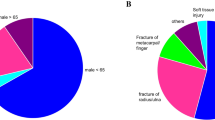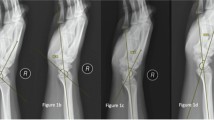Abstract
Objective
The aim of this study is to assess the applicability of standard adult carpal angle measurements, specifically the scapholunate and capitolunate angles, in the assessment of the pediatric wrist.
Materials and methods
The study cohort comprised male and female children who underwent a wrist radiograph for the evaluation of suspected wrist injuries following trauma. A gender- and indication-matched adult cohort was also assessed. To ensure an accurate carpal angle measurement, only individuals with a sufficiently ossified carpus and an adequately positioned lateral wrist radiograph were included.
Results
Carpal angle measurements were performed on the lateral wrist radiographs of 256 individuals between the ages of 5 and 17 years (mean 11.2 years, SD ± 2.5 years) and 256 individuals between the ages of 18 and 40 years (mean 28.8 years, SD ± 6.2 years). The mean pediatric scapholunate angle was 47° (SD ± 8) and the mean pediatric capitolunate angle was 11° (SD ± 7). The mean adult scapholunate and capitolunate angles were 48° (SD ± 8°) and 10° (SD ± 6°) respectively. No statistically significant difference was observed between the scapholunate or capitolunate angle measurements in the two groups (p = 0.26 and p = 0.36).
Conclusion
The study data supports the applicability of standard adult carpal angle values to the pediatric population provided the carpus is sufficiently ossified.









Similar content being viewed by others
References
Mariscalco MW, Saluan P. Upper extremity injuries in the adolescent athlete. Sports Med Arthrosc. 2011;19(1):17–26.
Cornwall R. The painful wrist in the pediatric athlete. J Pediatr Orthop. 2010;30:S13–6.
Lomasney LM, Lim-Dunham JE, Cappello T, Annes J. Imaging of the pediatric athlete: use and overuse. Radiol Clin N Am. 2013;51(2):215–26.
Ramavath AL, Unnikrishnan PN, George HL, Sathyamoorthy P, Bruce CE. Wrist arthroscopy in children and adolescent with chronic wrist pain: arthroscopic findings compared with MRI. J Pediatr Orthop. 2017;37(5):e321–5.
Collard DC, Verhagen EA, van Mechelen W, Heymans MW, Chinapaw MJ. Economic burden of physical activity-related injuries in Dutch children aged 10-12. Br J Sports Med. 2011;45(13):1058–63.
Bae D, Waters P. Upper extremity trauma in children and adolescents: an update from the hand and upper extremity program. Orthop J Harv Med Sch. 2003;5:122–5.
Green DP, Hotchkiss RN, Pederson WC. Green’s operative hand surgery. Fourth ed. 1999, New York: Churchill Livingstone.
Kaawach W, Ecklund K, Di Canzio J, Zurakowski D, Waters PM. Normal ranges of scapholunate distance in children 6 to 14 years old. J Pediatr Orthop. 2001;21(4):464–7.
Weissman B. Orthopedic radiology. 1986, Philadelphia, PA: Saunders.
Sarrafian SK, Melamed JL, Goshgarian GM. Study of wrist motion in flexion and extension. Clin Orthop Relat Res. 1977;126:153–9.
Elvey M, Patel S, Avisar E, White WJ, Sorene E. Defining occult injuries of the distal forearm and wrist in children. J Child Orthop. 2016;10(3):227–33.
Yang Z, Mann FA, Gilula LA, Haerr C, Larsen CF. Scaphopisocapitate alignment: criterion to establish a neutral lateral view of the wrist. Radiology. 1997;205(3):865–9.
Reader WJ. Professional men. The rise of the professional classes in nineteenth-century England. 1966. London: Weidenfeld & Nicolson.
Morgan W, Groves RJ. Scapholunate dissociation from a fall on the elbow. J Hand Surg [Am]. 1984;9(6):845–7.
Lister G. The hand: diagnosis and indications. 3rd ed. Edinburgh: Churchill Livingstone; 1993.
Blevens AD, Light TR, Jablonsky WS, Smith DG, et al. Radiocarpal articular contact characteristics with scaphoid instability. J Hand Surg [Am]. 1989;14(5):781–90.
Smith PJ, Lister GH. In: Smith P, editor. Lister's the hand: diagnosis and indications. 4th ed. London: Churchill Livingstone; 2002.
Earp BE, Waters PM, Wyzykowski RJ. Arthroscopic treatment of partial scapholunate ligament tears in children with chronic wrist pain. J Bone Joint Surg Am. 2006;88(11):2448–55.
Alt V, Gasnier J, Sicre G. Injuries of the scapholunate ligament in children. J Pediatr Orthop B. 2004;13(5):326–9.
Cho MS, Battista V, Dubin NH, Pirela-Cruz M. Assessment of four midcarpal radiologic determinations. Surg Radiol Anat. 2006;28(1):92–7.
Schuind F, Alemzadeh S, Stallenberg B, Burny F. Does the normal contralateral wrist provide the best reference for X-ray film measurements of the pathologic wrist? J Hand Surg [Am]. 1996;21(1):24–30.
Capo JT, Accousti K, Jacob G, Tan V. The effect of rotational malalignment on X-rays of the wrist. J Hand Surg Eur Vol. 2009;34(2):166–72.
Koh KH, Lee HI, Lim KS, Seo JS, Park MJ. Effect of wrist position on the measurement of carpal indices on the lateral radiograph. J Hand Surg Eur Vol. 2013;38(5):530–41.
Author information
Authors and Affiliations
Corresponding author
Rights and permissions
About this article
Cite this article
Joyce, E.A., Farrell, T., McMorrow, J. et al. Are adult carpal angle measurements applicable to the pediatric population in the trauma setting?. Skeletal Radiol 47, 1151–1156 (2018). https://doi.org/10.1007/s00256-018-2905-9
Received:
Revised:
Accepted:
Published:
Issue Date:
DOI: https://doi.org/10.1007/s00256-018-2905-9




